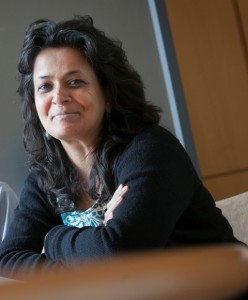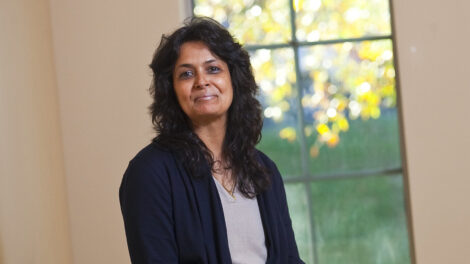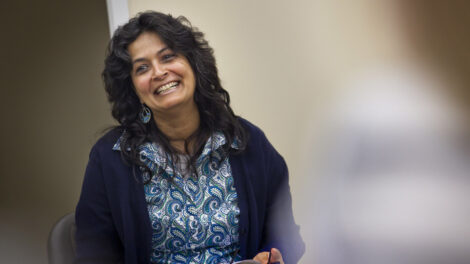By Shannon Sigafoos
Contentment with our lives and our circumstances seems to revolve around practicalities: Do we like and feel contentment with our jobs? Our home lives? Our relationships with family and friends? Can we make ends meet? Do we manage the stressors well in our lives? If the answer to even half of these questions is “yes,” it would make sense to say that this would lead to personal happiness and contentment. But, what about when it doesn’t? And, how does happiness change as we age?

Jamila Bookwala
A review paper published in Neuroscience and Behavioral Reviews and co-authored by Jamila Bookwala, dean of the faculty and professor of psychology, focuses on neurophysiological and biobehavioral processes that implement positive emotions and reviews the associations among neurotransmitters, hormones, brain networks, cognitive function, and social relationships in the context of positive emotions and affect.
“The Neuroscience of Positive Emotions and Affect: Implications for Cultivating Happiness and Wellbeing” has been published in Science Direct’s journal Neuroscience and Biobehavioral Reviews, Volume 121, February 2021. The review is part of “The Human Affectome Project” and is the outcome of a collaborative work process that includes intellectual contributions from 17 authors around the world.
“I study emotional well-being from a lifespan perspective, focusing on middle and late life. In my own FYS course on understanding happiness, we cover how the brain is incredibly resilient. As we age, we know that structurally, the brain changes, and we experience shrinkage and some atrophy. And yet, we have a better capacity to be happy as we get older, which is just such a fascinating idea,” shares Bookwala. “My research looks at what factors can promote emotional well-being in the face of what are considered normative stressors in late life, such as caregiving or a physical health impairment. I’ve always been interested in factors that promote resilience in the face of such stressors.”
Coming off of a year in which the world has been experiencing a myriad of emotional effects due to the COVID-19 pandemic, the question of resilience—and what happiness really is—proves to be an interesting one that every person would have a different answer to.
“What do we mean by happiness?” asks Bookwala. “One of the first tasks we [the authors] contributed to was a linguistic exercise about what words communicate happiness. It could be ‘joy’ or it could be ‘contentment.’ At the heart of this review paper is understanding happiness and well-being from a neurological standpoint and a behavioral standpoint.”
Can happiness motivate you to be more engaged? Do you get happiness from exercising? Playing an instrument? Cooking a meal for your family? What defines happiness is unique to each individual. The research presented in “The Neuroscience of Positive Emotions and Affect” also discusses how happiness varies across individuals, over the lifespan, and by geographic region. Bookwala’s contributions to the article were related to positive emotions and well-being over the human lifespan and global trends in happiness.
The United Nations commissioned its first World Happiness Report (WHR) in 2012 and suggested that some geographical regions score above and below the mean global level of happiness and that nearly 75% of the variability in global levels of happiness falls under six factors: the perceived ability of social support, national gross domestic product (GDP), average health life expectancy, the perceived freedom to make life choices, generosity, and perceived levels of corruption. While North America falls above the mean global level, our responses to national events also play a part in our happiness.
“In terms of what has happened over the past year with the virus, with racial injustice, and with political tensions, it has been a year where finding happiness in this country has been a challenge. It’s been a struggle. And I do think we’re resilient as people, and we’ve learned so much about ourselves—including what can keep us happy in very difficult times,” says Bookwala. “People have different thresholds for and different pathways to happiness.”
Bookwala also goes on to discuss how gratitude and balanced social relationships are important elements of happiness, citing the book Flourish: A New Understanding of Happiness and Wellbeing (by Martin Seligman) that students read in her FYS.
“Social relationships are a part of happiness. We are social beings and isolation is not something we enjoy. But when I say isolation, I do not mean solitude; it is possible to be happy in solitude. Our own role in cultivating and maintaining happiness is very real. And what is interesting is, as we get older, we pick who we want to spend our time with much more carefully,” says Bookwala. “We’re much more selective, because we want to be with people who increase our emotional well-being. The Socioemotional Selectivity Theory of Aging [developed by Stanford University psychologist Laura Carstensen] explains that as we get older, we still want to be with people, but we want to be with people with whom we are closest. Our social circles shrink, but we shrink them selectively.”
“For me, personally, I get tremendous joy from my family and friends. And from my work. For this, I’m very grateful,” Bookwala shares.


